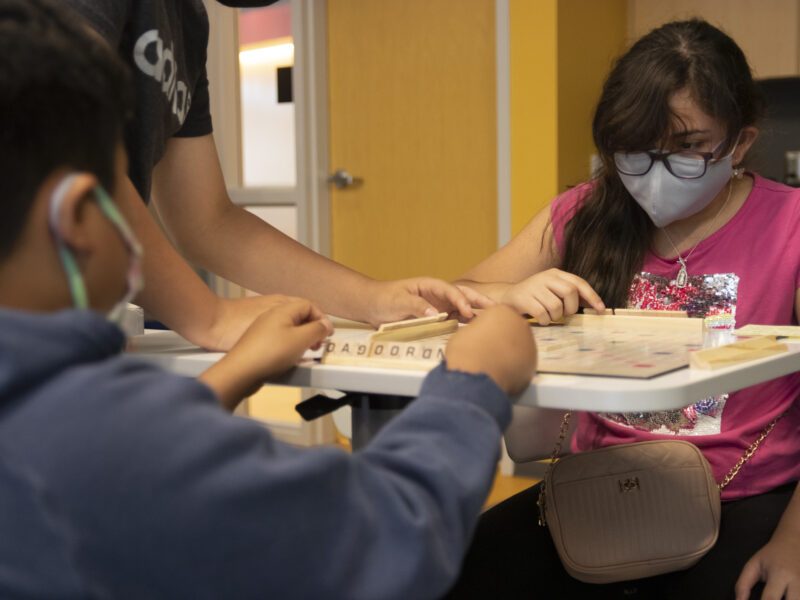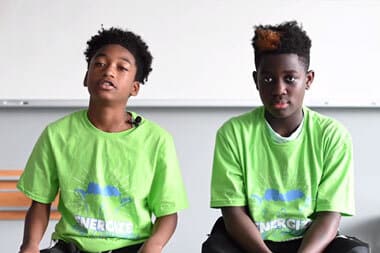 Youth Work 101: Gamifying Lessons
Youth Work 101: Gamifying LessonsThis month’s blog on gamifying lessons is paraphrased from an interview with Ellen Holmes, a mentor teacher at Student U, with writing by Dexter Phuong a Student U Marketing and Communications Intern.
Welcome to the Youth Work 101 Series! Student U uses this blog series to support youth work practitioners, educators, advocates for young people, and after-school professionals in their work by sharing what has worked for us and by offering free resources each month on a best practice.
Hello there! My name is Dexter, and this past summer I worked as an intern on the advancement team at Student U during Summer Academy. During my time there I was able to experience Student U’s summer program in all its (in person) glory, and I was surrounded by wonderful teachers and brilliant students every day. Although the summer was filled with memorable moments with students, one thing I learned from the teachers there was that keeping students engaged during class is an extremely difficult task; and living in a world filled with mobile phones, social media and of course TikTok makes this even harder. Thus, teachers had to find innovative ways to keep their students engaged and energized during lessons. One way they did this was by “gamifying” their lessons.
You might be wondering, “what does it mean to gamify a lesson?” To answer that question, gamification is simply the process of incorporating elements of gaming into lesson plans. This does not mean replacing entire lessons with games, but rather adding small elements (like badges or point systems) to make the content more memorable, engaging, and fun.
Why Should You Invest in Gamifying Your Lessons?Playing games is fun and engaging. Many people pour hours into gaming without complaining, whether it’s playing your favorite card game with friends or finishing a mission in Fortnite after hours of hard work. People love games because they are exciting, gratifying, and make you feel accomplished.
You can tap into that kind of engagement through gamification. When applying game elements to non-game environments, there is a higher chance for participation and even motivation. A simple example is a hotel chain, airline, or credit card reward system, where points earned offer customers perks like free rooms, flights, upgrades, or other amenities.
6 Tips to Help You Start Gamifying Your Lessons
1. Start by defining your goals and objectivesLike any other endeavor, you should start by figuring out exactly what you want to achieve by gamifying a lesson. For example, is your goal to improve knowledge retention, create a sense of community in your classroom, or something else? Starting with a solid foundation can help the planning process and give you a sense of what your students really need from gamified lessons. 2. Start simple and gradually build upon that foundation
Gamifying lessons can be a daunting task, especially since there are so many different types of games, thus it is important to start simple. Ms. Holmes recommends starting with 3 games you feel comfortable with and then gauging student interaction while playing these games. Scavenger hunts, bingo, dice games, Connect Four, and Scrabble have been around for decades and can easily be adapted for classroom learning. Put vocabulary words on bingo cards and see if students can match the words after hearing the definitions. Working in groups, students can play Scrabble by spelling out answers to content-specific questions. Try incorporating a scavenger hunt. If students are remote, you might provide students with a list of items to find around their home and then share on Zoom or during a Google Meet. Watching for feedback is also extremely important to see whether the games are suitable for your lessons. You can continue to use the three games you are comfortable with or switch it up if you would like. Just make sure to go at your own pace! 3. Try incorporating achievements or badges
Badges and achievements require learners to spend more time practicing and exploring lesson outcomes. They are non-competitive ways for individuals to explore areas of personal interest and push themselves to accomplish the required goals. Students can earn achievements for attaining specific levels, trying out a new skill for the first time, reading a number of articles or books, or demonstrating skills like collaboration or creativity. 4. Be adaptable
Make sure your games are adaptable to any subject, activity, or situation. It can be fun to switch up games to see what works better for you and your class, but it is crucial that your game works in harmony with your lesson. You want to make sure your students can easily understand and follow the game. 5. Use online resources and tools
There is an abundance of resources online to help you decide how you want to gamify your lessons. You can find fun games you never knew existed from a quick Google search or by reading articles just like this one. Online resources can be especially useful when you are looking for games that relate to the specific subject you teach or even entire lessons you plan to incorporate during the school year. At Student U, teachers have incorporated online games such as Kahoot, Class Dojo, heads up, and wheel of fortune. These games are great ways to keep students involved in a fun yet educational way. 6. Learn from other educators
If browsing the internet is not your forte, it is always good to learn from other educators. Communication and collaboration are key components of 21st-century education, and they’re applicable to professional development, too. Educators interested in gamification are not alone, and they can benefit from sharing knowledge and ideas with each other.
I encourage teachers to try out gamification in their classrooms because it not only adds variety to teaching, but it also helps keep students engaged. Students will gravitate towards games because they are usually familiar with how they work. Overall, games can be an incredible way to make lesson plans more interactive and memorable for students in the long-run.
Donate to Student U and keep posts like this one coming.
Subscribe to this blog to receive regular Youth Work 101 articles and free resources.










